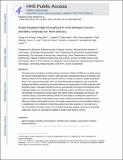| dc.contributor.author | Chang, Tsung-Yao | |
| dc.contributor.author | Chatnuntawech, Itthi | |
| dc.contributor.author | Yanik, Mehmet Fatih | |
| dc.contributor.author | Tillberg, Paul W. | |
| dc.contributor.author | Eimon, Peter | |
| dc.contributor.author | Anderson, Daniel Griffith | |
| dc.contributor.author | Shi, Peng, Ph. D. Massachusetts Institute of Technology | |
| dc.contributor.author | Steinmeyer, Joseph Daly | |
| dc.contributor.author | Love, Kevin T | |
| dc.date.accessioned | 2016-02-09T18:02:55Z | |
| dc.date.available | 2016-02-09T18:02:55Z | |
| dc.date.issued | 2014-08 | |
| dc.date.submitted | 2014-06 | |
| dc.identifier.issn | 1757-9694 | |
| dc.identifier.issn | 1757-9708 | |
| dc.identifier.uri | http://hdl.handle.net/1721.1/101138 | |
| dc.description.abstract | Therapies based on biologics involving delivery of proteins, DNA, and RNA are currently among the most promising approaches. However, although large combinatorial libraries of biologics and delivery vehicles can be readily synthesized, there are currently no means to rapidly characterize them in vivo using animal models. Here, we demonstrate high-throughput in vivo screening of biologics and delivery vehicles by automated delivery into target tissues of small vertebrates with developed organs. Individual zebrafish larvae are automatically oriented and immobilized within hydrogel droplets in an array format using a microfluidic system, and delivery vehicles are automatically microinjected to target organs with high repeatability and precision. We screened a library of lipid-like delivery vehicles for their ability to facilitate the expression of protein-encoding RNAs in the central nervous system. We discovered delivery vehicles that are effective in both larval zebrafish and rats. Our results showed that the in vivo zebrafish model can be significantly more predictive of both false positives and false negatives in mammals than in vitro mammalian cell culture assays. Our screening results also suggest certain structure–activity relationships, which can potentially be applied to design novel delivery vehicles. | en_US |
| dc.description.sponsorship | National Institutes of Health (U.S.) (Transformative Research Award R01 NS073127) | en_US |
| dc.description.sponsorship | National Institutes of Health (U.S.) (Director's Innovator Award DP2 OD002989) | en_US |
| dc.description.sponsorship | David & Lucile Packard Foundation (Award in Science and Engineering) | en_US |
| dc.description.sponsorship | Sanofi Aventis (Firm) | en_US |
| dc.description.sponsorship | Foxconn International Holdings Ltd. | en_US |
| dc.description.sponsorship | Hertz Foundation (Fellowship) | en_US |
| dc.description.sponsorship | University Grants Committee (Hong Kong, China) (Early Career Award 125012) | en_US |
| dc.description.sponsorship | National Natural Science Foundation (China) (81201164) | en_US |
| dc.description.sponsorship | ITC (ITS/376/13) | en_US |
| dc.description.sponsorship | Chinese University of Hong Kong (Grant 9610215) | en_US |
| dc.description.sponsorship | Chinese University of Hong Kong (Grant 7200269) | en_US |
| dc.language.iso | en_US | |
| dc.publisher | Royal Society of Chemistry | en_US |
| dc.relation.isversionof | http://dx.doi.org/10.1039/c4ib00150h | en_US |
| dc.rights | Creative Commons Attribution-Noncommercial-Share Alike | en_US |
| dc.rights.uri | http://creativecommons.org/licenses/by-nc-sa/4.0/ | en_US |
| dc.source | PMC | en_US |
| dc.title | Organ-targeted high-throughput in vivo biologics screen identifies materials for RNA delivery | en_US |
| dc.type | Article | en_US |
| dc.identifier.citation | Chang, Tsung-Yao, Peng Shi, Joseph D. Steinmeyer, Itthi Chatnuntawech, Paul Tillberg, Kevin T. Love, Peter M. Eimon, Daniel G. Anderson, and Mehmet Fatih Yanik. “Organ-Targeted High-Throughput in Vivo Biologics Screen Identifies Materials for RNA Delivery.” Integr. Biol. 6, no. 10 (August 5, 2014): 926–934. | en_US |
| dc.contributor.department | Massachusetts Institute of Technology. Institute for Medical Engineering & Science | en_US |
| dc.contributor.department | Harvard University--MIT Division of Health Sciences and Technology | en_US |
| dc.contributor.department | Massachusetts Institute of Technology. Department of Chemical Engineering | en_US |
| dc.contributor.department | Massachusetts Institute of Technology. Department of Electrical Engineering and Computer Science | en_US |
| dc.contributor.department | Massachusetts Institute of Technology. Research Laboratory of Electronics | en_US |
| dc.contributor.department | Koch Institute for Integrative Cancer Research at MIT | en_US |
| dc.contributor.mitauthor | Chang, Tsung-Yao | en_US |
| dc.contributor.mitauthor | Shi, Peng | en_US |
| dc.contributor.mitauthor | Steinmeyer, Joseph D. | en_US |
| dc.contributor.mitauthor | Chatnuntawech, Itthi | en_US |
| dc.contributor.mitauthor | Tillberg, Paul W. | en_US |
| dc.contributor.mitauthor | Love, Kevin T. | en_US |
| dc.contributor.mitauthor | Eimon, Peter | en_US |
| dc.contributor.mitauthor | Anderson, Daniel Griffith | en_US |
| dc.contributor.mitauthor | Yanik, Mehmet Fatih | en_US |
| dc.relation.journal | Integrative Biology | en_US |
| dc.eprint.version | Author's final manuscript | en_US |
| dc.type.uri | http://purl.org/eprint/type/JournalArticle | en_US |
| eprint.status | http://purl.org/eprint/status/PeerReviewed | en_US |
| dspace.orderedauthors | Chang, Tsung-Yao; Shi, Peng; Steinmeyer, Joseph D.; Chatnuntawech, Itthi; Tillberg, Paul; Love, Kevin T.; Eimon, Peter M.; Anderson, Daniel G.; Yanik, Mehmet Fatih | en_US |
| dc.identifier.orcid | https://orcid.org/0000-0003-0447-517X | |
| dc.identifier.orcid | https://orcid.org/0000-0002-4916-6314 | |
| dc.identifier.orcid | https://orcid.org/0000-0001-5629-4798 | |
| dc.identifier.orcid | https://orcid.org/0000-0003-0254-4741 | |
| dc.identifier.orcid | https://orcid.org/0000-0001-8946-8205 | |
| mit.license | OPEN_ACCESS_POLICY | en_US |
